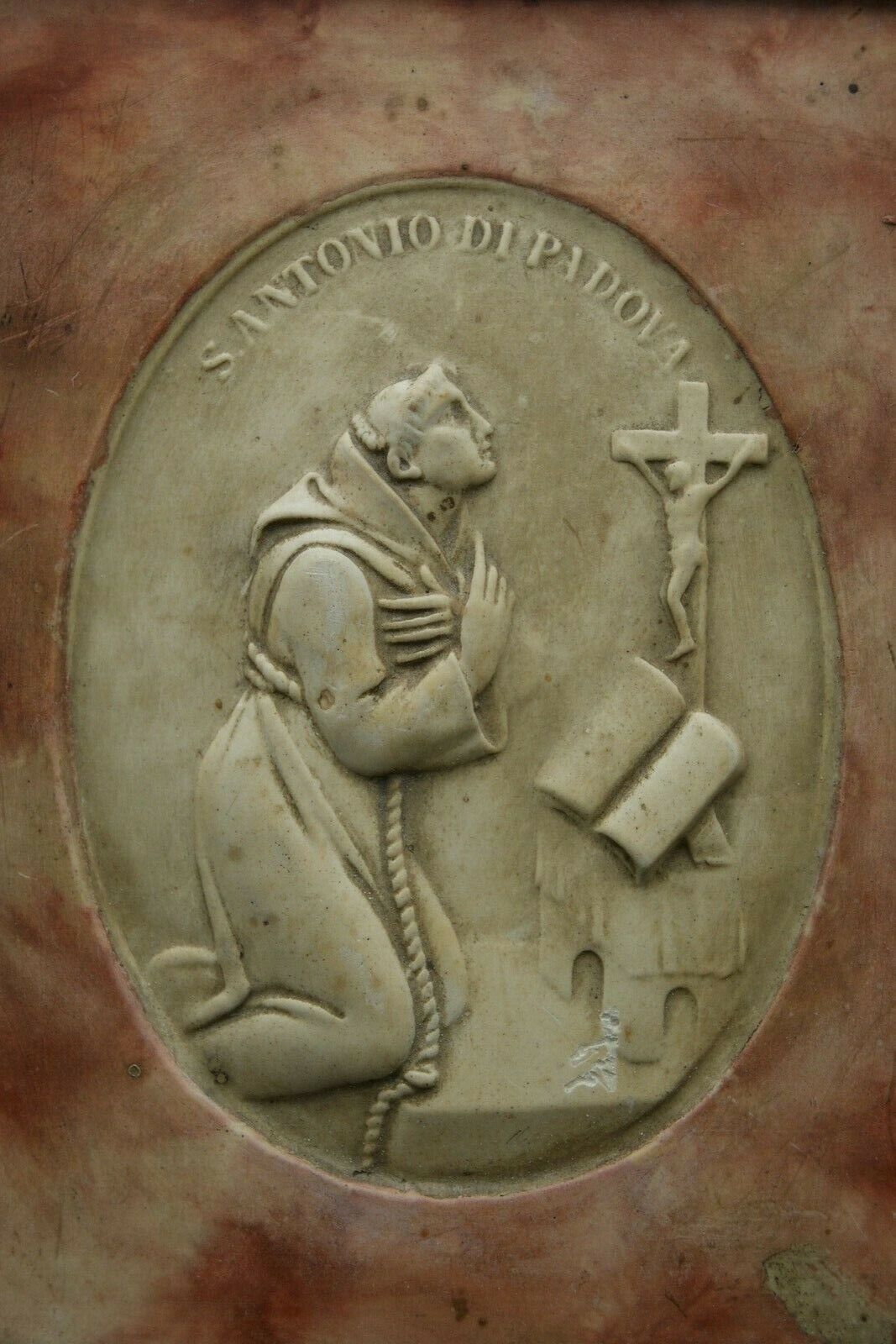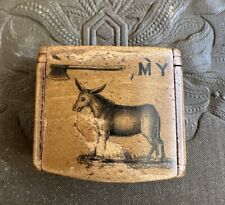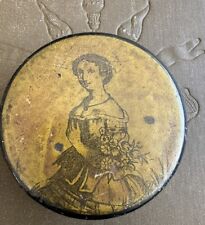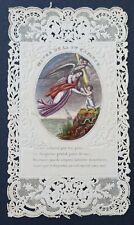When you click on links to various merchants on this site and make a purchase, this can result in this site earning a commission. Affiliate programs and affiliations include, but are not limited to, the eBay Partner Network.
SAINT ANTHONY of PADUAEVANGELICAL DOCTORFrom PADUA - ITALY
1 OLD COLORED PLASTER / CHALKWAREFRANCISCAN PRIESTPERIOD : 1800\'s
VISIT MY FRENCH ANTIQUES SHOP!!!
Frame : 220 X 185 X 11mm.Frame :150X115mm.375 grs.
Anthony of Padua
Saint
Anthony of PaduaAnthony of PaduabyFrancisco de Zurbarán, 1627–1630Evangelical Doctor
Hammer of Heretics
Professor of Miracles
Doctor of the ChurchBorn15 August 1195
Lisbon,PortugalDied13 June ChurchBeatified30 May 1232Canonized30 May 1232, Spoleto, Italy by Pope Gregory IXMajorshrineBasilica of Saint Anthony of Padua, ItalyFeast13 JuneAttributesBook; bread;Infant Jesus; lily; fish; flaming heart; mulePatronageLisbon, Lost items, lost people, lost souls,American Indians; amputees; animals;barrenness;Brazil;elderly people;faith in the Blessed Sacrament;fishermen; Franciscan Custody of the Holy Land;harvests; horses; lower animals; mail;mariners; oppressed people;poor people;Portugal;pregnant Tigua Indians; travel hostesses; travellers;Tuburan,Cebu; San Vicente,Sulat, Eastern Samar;Watermen; runts of litters;counter-revolutionaries;Pila, Laguna,Taytay, Rizal;Iriga, Camarines Sur;Camaligan, Camarines Sur
Anthony of Padua(Portuguese:António de Pádua; bornFernando Martins de Bulhões; 15 August 1195 – 13 June 1231[1]), also known asAnthony of Lisbon(Portuguese:António de Lisboa), was aPortugueseCatholicpriestandfriarof theFranciscan Order. He was born and raised by a wealthy family inLisbon,Portugal, and died inPadua,Italy. Noted by his contemporaries for his powerful preaching, expert knowledge of scripture, and undying love and devotion to the poor and the sick, he was one of the most quicklycanonizedsaints in church history. He was proclaimed aDoctor of the Churchon 16 January 1946. He is also the patron saint of lost things.
Life[edit]Basilica of Saint Anthony of Padua- Padua, ItalyEarly years[edit]
Fernando Martins de Bulhões was born inLisbon,Portugal.[2]While 15th-century writers state that his parents were Vicente Martins and Teresa Pais Taveira, and that his father was the brother of Pedro Martins de Bulhões, the ancestor of the Bulhão or Bulhões family, Niccolò Dal-Gal views this as less certain.[2]His wealthy and noble family arranged for him to be instructed at the local cathedral school. At the age of 15, he entered theAugustiniancommunity ofCanons Regular of the Order of the Holy Crossat theAbbey of Saint Vincenton the outskirts of Lisbon.
In 1212, distracted by frequent visits from family and friends, he asked to be transferred to the motherhouse of the congregation, theMonastery of the Holy CrossinCoimbra, then the capital of Portugal.[3]There, the young Fernando studiedtheologyandLatin.
Joining the Franciscans[edit]InAlvise Vivarini\'s painting, Anthony is distinguished from the other saints by his attributes: the book and the white lily stalk.
After hisordinationto the priesthood, Fernando was named guestmaster at the age of 19, and placed in charge of hospitality for the abbey. While he was in Coimbra, someFranciscanfriars arrived and settled at a small hermitage outside Coimbra dedicated toAnthony of Egypt.[3]Fernando was strongly attracted to the simple,evangelicallifestyle of the friars, whose order had been founded only 11 years prior. News arrived that five Franciscans had been beheaded in Morocco,the first of their order to be killed. KingAfonso IIransomed their bodies to be returned and buried as martyrs in the Abbey of Santa Cruz.[3]Inspired by their example, Fernando obtained permission from church authorities to leave theCanons Regularto join the new Franciscan order. Upon his admission to the life of the friars, he joined the smallhermitageinOlivais, adopting the name Anthony (from the name of the chapel located there, dedicated toAnthony the Great), by which he was to be known.[4]
Anthony then set out for Morocco, in fulfillment of his newvocation. However, he fell seriously ill in Morocco and set sail back for Portugal in hope of regaining his health. On the return voyage, the ship was blown off course and landed in Sicily.[5]
From Sicily, he made his way toTuscany, where he was assigned to aconventof the order, but he met with difficulty on account of his sickly appearance. He was finally assigned to the rural hermitage of San Paolo nearForlì,Romagna, a choice made after considering his poor health. There, he had recourse to a cell one of the friars had made in a nearby cave, spending time in private prayer and study.[6]
Preaching and teaching[edit]Saint Anthony of Padua Holding Baby JesusbyStrozzi, c. 1625; the whitelilyrepresents purity.
One day in 1222, in the town of Forlì, on the occasion of an ordination, a number of visitingDominicanfriars were present, and some misunderstanding arose over who should preach. The Franciscans naturally expected that one of the Dominicans would occupy the pulpit, for they were renowned for their preaching; the Dominicans, though, had come unprepared, thinking that a Franciscan would be the homilist. In this quandary, the head of the hermitage, who had no one among his own humble friars suitable for the occasion, called upon Anthony, whom he suspected was most qualified, and entreated him to speak whatever the Holy Spirit should put into his mouth.[5]Anthony objected, but was overruled, and his sermon created a deep impression. Not only his rich voice and arresting manner, but also the entire theme and substance of his discourse and his moving eloquence, held the attention of his hearers. Everyone was impressed with his knowledge of scripture, acquired during his years as an Augustinian friar.
At that point, Anthony was sent by Brother Gratian, the localminister provincial, to the Franciscan province of Romagna, based inBologna.[5]He soon came to the attention of the founder of the order,Francis of Assisi. Francis had held a strong distrust of the place of theological studies in the life of his brotherhood, fearing that it might lead to an abandonment of their commitment to a life of real poverty. In Anthony, however, he found a kindred spirit for his vision, who was also able to provide the teaching needed by young members of the order who might seek ordination. In 1224, he entrusted the pursuit of studies for any of his friars to the care of Anthony.
The reason St. Anthony\'s help is invoked for finding things lost or stolen is traced to an incident that occurred in Bologna. According to the story, Anthony had a book of psalms that was of some importance to him, as it contained the notes and comments he had made to use in teaching his students. A novice who had decided to leave took the psalter with him. Prior to the invention of the printing press, any book was an item of value, and would have been difficult for a Franciscan friar to replace given his vow of poverty. Upon noticing it was missing, Anthony prayed it would be found or returned. The thief was moved to restore the book to Anthony and return to the order. The stolen book is said to be preserved in the Franciscan friary in Bologna.[7]
Occasionally, he took another post, as a teacher, for instance, at the universities ofMontpellierandToulousein southern France, but as a preacher Anthony revealed his supreme gift. According to historian Sophronius Clasen, Anthony preached the grandeur of Christianity.[6]His method included allegory and symbolical explanation of Scripture. In 1226, after attending thegeneral chapterof his order held atArles, France, and spreading the word of the Lord in the French region ofProvence, Anthony returned to Italy and was appointed provincial superior of northern Italy. He chose the city of Padua as his location.
In 1228, he served as envoy from the general chapter toPope Gregory IX. At the papal court, his preaching was hailed as a \"jewel case of the Bible\" and he was commissioned to produce his collection of sermons,Sermons for Feast Days(Sermones in Festivitates). Gregory IX himself described him as the \"Ark of the Testament\" (Doctor Arca testamenti).
Legends[edit]Saint Anthony Preaching to the Fishes, c. 1630
Anthony went to preach in Rimini, where the heretics treated him with contempt. So, instead he took himself to the shore-line and began to preach to the fish. A great crowd of fish arrayed themselves. The citizens flocked to see this marvel, and Anthony charged them with the fact that irrational creatures were more receptive than the unfaithful of Rimini, at which point the people gave ear to his sermons.[8]
In Toulouse, Anthony was challenged by a heretic to prove the reality of the presence of Christ in the Eucharist. The heretic brought a half-starved mule and waited to see its reaction when shown fresh fodder on one hand, and the sacrament on the other. The dumb animal ignored the fodder and bowed before the sacrament.[8]
Once in Italy, Anthony was dining with heretics, when he realized the food put before him was poisoned. When he reproached them for their conduct, they admitted to attempting to poison him, and dared him to eat if he truly believed the words spoken in Mark 16:18, \"...and if they drink any deadly thing, it will not harm them.\" Anthony blessed the food, ate it, and suffered no harm, much to the amazement of his hosts.[8]
Death[edit]Anthony of Padua with the Infant JesusbyAntonio de Pereda, detail
Anthony became sick withergotismin 1231, and went to the woodland retreat atCamposampierowith two other friars for a respite. There, he lived in acellbuilt for him under the branches of a walnut tree. Anthony died on the way back to Padua on 13 June 1231 at thePoor Claremonastery at Arcella (now part of Padua), aged 35.
According to the request of Anthony, he was buried in the small church of Santa Maria Mater Domini, probably dating from the late 12th century and near a convent which had been founded by him in 1229. Nevertheless, due to his increased notability, construction of a largebasilicabegan around 1232, although it was not completed until 1301. The smaller church was incorporated into structure as the Cappella della Madonna Mora (Chapel of the Dark Madonna). The basilica is commonly known today as \"Il Santo\" (The Saint).
Various legends surround the death of Anthony. One holds that when he died, the children cried in the streets and that all the bells of the churches rang of their own accord. Another legend regards his tongue. Anthony is buried in a chapel within the largebasilicabuilt to honor him, where his tongue is displayed forvenerationin a largereliquaryalong with his jaw and his vocal cords. When his body was exhumed 30 years after his death, it was found turned to dust, but the tongue was claimed to have glistened and looked as if it were still alive and moist; apparently a further claim was made that this was a sign of his gift of preaching.[citation needed]On 1 January 1981, PopeJohn Paul IIauthorized a scientific team to study Anthony\'s remains and the tomb was opened on 6 January.[9]
Saint and Doctor of the Church[edit]St Anthony of Padua and St Francis of Assisi by Friedrich Pacher
Anthony wascanonizedby Pope Gregory IX on 30 May 1232, atSpoleto, Italy, less than one year after his death.[2]
\"The richness of spiritual teaching contained in theSermonswas so great that in [16 January] 1946VenerablePope Pius XIIproclaimed Anthony a Doctor of the Church, attributing to him the titleDoctor Evangelicus[\"Evangelical Doctor\"], since the freshness and beauty of the Gospel emerge from these writings.\"[10]
Veneration as patron saint[edit]El Greco\'spainting, 1580, shows the book with an image of the Christ child on the page.
Anthony\'s fame spread through Portuguese evangelization, and he has been known as the most celebrated of the followers of Francis of Assisi. He is the patron saint ofLisbon, Padua and many places inPortugaland in the countries of the formerPortuguese Empire.[11]
He is especially invoked and venerated all over the world as the patron saint for the recovery of lost items and is credited with many miracles involving lost people, lost things and even lost spiritual goods.[11][12]
St. Anthony Chaplets help devotees to meditate on the thirteen virtues of the saint. Some of these chaplets were used by members of confraternities which had Anthony as their patron saint.
North America[edit]First class relic of Anthony displayed at the National Shrine of St. Anthony of Padua and Friary (Cincinnati, Ohio)
In 1692, Spanish missionaries came across a smallPayaya Indiancommunity along what was then known as theYanaguanaRiver on the feast day of Saint Anthony, 13 June. The Franciscan chaplain, Father Damien Massanet, with agreement from General Domingo de Teran, renamed the rivers in his honor, and eventually builta mission nearby, as well. This mission became the focal point of a small community that eventually grew in size and scope to become the seventh-largest city in the country, theU.S. city of San Antonio, Texas.[13]
InNew York City, theShrine Church of St. AnthonyinGreenwich Village,Manhattancelebrates hisfeast day, starting with the traditionalnovenaof prayers asking for his intercession on the 13 Tuesdays preceding his feast. This culminates with a week-long series of services and a street fair. A traditional Italian-style procession is held that day through the streets of itsSouth Villageneighborhood, during which arelicof the saint is carried forveneration.[14]
Miraculous Image of Saint Anthony, by Franciszek Lekszycki OFM, 1649,Przeworsk, Poland
Each year on the weekend of the last Sunday in August,Boston\'s North Endholds a feast in honor of Saint Anthony. Referred to as the \"Feast of All Feasts\",Saint Anthony\'s Feastin Boston\'s North End was begun in 1919 by Italian immigrants fromMontefalcione, a small town nearNaples, where the tradition of honoring Saint Anthony goes back to 1688.[15]
Each year theSandia Puebloalong withSanta Clara Pueblocelebrates the feast day of Saint Anthony with traditional Native American dances.[16]
On 27 January 1907, inBeaumont, Texas, a church was dedicated and named in honor of Saint Anthony. The church was later designated a cathedral in 1966 with the formation of theRoman Catholic Diocese of Beaumont, but was not formally consecrated. On 28 April 1974, St. Anthony Cathedral was dedicated and consecrated by Bishop Warren Boudreaux. In 2006,Pope Benedict XVIgranted the cathedral the designation of minor basilica.St. Anthony Cathedral Basilicacelebrated its 100th anniversary on 28 January 2007.[17]
St. Anthony gives his name toMission San Antonio de Padua, the third Franciscan mission dedicated alongEl Camino RealinCaliforniain 1771.[18]
InEllicott City, Maryland, southwest ofBaltimore, the Conventual Franciscans of the St. Anthony Province dedicated their old novitiate house as theShrine of St. Anthonywhich since 1 July 2004 serves as the official shrine to Saint Anthony for theArchdiocese of Baltimore.[19]
Brazil and Europe[edit]Saint-Antoine de Padoue parish in Wavre, BelgiumSanto Antônio (Saint Anthony) Church inTeresópolis,Brazil
Saint Anthony is known in Portugal, Spain, and Brazil as a marriage saint, because legends exist of him reconciling couples. His feast day, 13 June, is Lisbon\'s municipal holiday, celebrated with parades and marriages (the previous day, 12 June, is theDia dos Namoradosin Brazil). He is one of the saints celebrated in the BrazilianFesta Junina, along withJohn the BaptistandSaint Peter. He is venerated in Mogán Village inGran Canaria, where his feast day is celebrated every year with oversized objects carried through the streets for the fiesta.[20]
In the town ofBrusciano, Italy, located near Naples, an annual feast in honor of Saint Anthony is held in late August. This tradition dates back to 1875. The tradition started when a man prayed to Saint Anthony for his sick son to get better. He vowed that if his son would become healthy that he would build and dance agigliolike the people of Nola do for their patron San Paolino during the annual Fest Dei Gigli. (Agigliois a tall tower topped with a statue of the saint that is carried through the streets in carefully choreographed maneuvers that resemble a dance.) The celebration has grown over the years to include six giglio towers built in honor of the saint. This tradition has also carried over to America, specifically theEast Harlemarea of New York, where the immigrants from the town of Brusciano formed theGiglio Society of East Harlemand have been holding their annual feast since the early 1900s.[21]
InAlbania, theFranciscansarrived in 1240 spreading the word of Saint Anthony. TheSt. Anthony Church, Laç(Albanian:Kisha e Shna Ndout or Kisha e Laçit) inLaçwas built in his honor.[22]
InPoland, he is the patron saint ofPrzeworsk. Theiconof Saint Anthony, dating from 1649, is housed in a local (Franciscan church,Kaplica Świętego Antoniego w Przeworsku[pl]).
Asia[edit]This sectionneeds additional citations forverification.Please helpimprove this articlebyadding citations to reliable sources. Unsourced material may be challenged and removed.
Find sources:\"Anthony of 2017)(Learn how and when to remove this template message)St. Anthony of Padua in St. Joseph\'s Church,Macao
Devotion to Saint Anthony is popular throughout all of India. InUvari, inTamil Nadu, India, the church of Saint Anthony is home to an ancient wooden statue that is said to have cured the entire crew of a Portuguese ship suffering fromcholera. Saint Anthony is said to perform many miracles daily, and Uvari is visited by pilgrims of different religions from all over South India. Christians in Tamil Nadu have great reverence for Saint Anthony and he is a popular saint there, where he is called the \"Miracle Saint.\"
Also in India, a small crusady known with the name of Saint Anthony is located in the village called Pothiyanvilai, state of Tamil Nadu Kanyakumari district near Thengapattinam, where thousands of devotees attend every Tuesday and Friday to receive his blessings, miracles, and guidings directly from St. Anthony\'s soul entering in the body of a holy person for the last 34 years. The southern Indian state of Karnataka is also a holy pilgrimage center in honor of Saint Anthony (specifically located in the small village of Dornahalli, near Mysore). Local lore holds that a farmer there unearthed a statue that was later identified as being that of Saint Anthony. The statue was deemed miraculous and an incident of divine intervention. A church was then erected to honor the saint. Additionally, Saint Anthony is highly venerated inSri Lanka, and the nation\'sSaint Anthony National Shrinein Kochikade,Colombo, receives many devotees of Saint Anthony, both Catholic and non-Catholic. There is also a church in Pakistan of Saint Anthony of Padua in the city ofSargodhaunder the Diocese of Rawalpindi.
National Shrine of St. Anthony of Padua,Pila, Laguna,Philippineswhere Franciscans established the first church in the country dedicated to St. Anthony of Padua under theDiocese of San Pablo
In thePhilippines, the devotion to St. Anthony of Padua began in 1581, in the town ofPila, Laguna, where Franciscans established the first church in the country dedicated to St. Anthony of Padua, now elevated as theNational Shrine of St. Anthony of Paduaunder theDiocese of San Pablo.
InSiolim, a village in the Indian state ofGoa, St. Anthony is always shown holding a serpent on a stick. This is a depiction of the incident which occurred during the construction of the church wherein a snake was disrupting construction work. The people turned to St. Anthony for help and placed his statue at the construction site. The next morning, the snake was found caught in the cord placed in the statue\'s hand.[23]
In art[edit]Giacomo Farelli– St. Antony of Padua
As the number of Franciscan saints increased, iconography struggled to distinguish Anthony from the others. Because of a legend that he had once preached to the fish by the mouth of the riverMarecchiainRimini, this was sometimes used as his attribute. He is also often seen with a whitelilystalk, representing his purity. Other conventions referred to St. Anthony\'s visionary fervor. Thus, one attribute in use for some time was a flaming heart. He is also sometimes depicted along with themulein Rimini that allegedly bowed down to him holding theEucharist.
In 1511,Titianpainted three large frescoes in theScuola del Santoin Padua, depicting scenes of the miracles from the life of Saint Anthony:TheMiracle of the Jealous Husband, which depicts the murder of a young woman by her husband;A Child Testifying to Its Mother\'s Innocence; andThe Saint Healing the Young Man with a Broken Limb.[24]
Another key pattern has him meditating on an open book in which the Christ Child himself appears, as in the El Greco above. Over time the child came to be shown considerably larger than the book and some images even do without the book entirely. He typically appears carrying the infant Jesus and holding a cross.[25]
In popularvotive offerings, Anthony is often depicted as miraculously saving individuals in various accidents.[26]
- Anthony of Padua in Art
An early work byRaphael, 1503, at theDulwich Picture Gallery, London, UK
Baby Jesus with St. Anthony of Padua,Elisabetta Sirani, 1656,Bologna, Italy
Anthony of Padua with the Infant JesusbyAntonio de Pereda
St Antony Reading, early 17th century, byMarco Antonio Bassetti
Triptych of Saint Antonius byAmbrosius Benson
Saint Anthony of Padua with the Infant ChristbyGuercino, 1656,Bologna, Italy
Vision of Saint Anthony, byAlonso Cano
St. Antony with Christ Child, from,Carinthia, in Austria
Saint Anthony of Padua and the miracle of the mule, byAnthony van Dyck.
St. Anthony of Padua Preaching to the Fish, byVictor Wolfvoet II.
St Anthony holding Baby Jesus
Livraison et Expédition(Shipping & Handling)
- Les pièces seront soigneusement emballées individuellement et protégées avec du film bulle et carton renforcé,
- Pour les pays autres que la France, envoi en recommandé avec assurance Ad Valorem à hauteur de la valeur de l\'objet.
- All items will be securely packed, individually wrapped with acid-free silk paper, foam, bubble wrap and reinforced cardboard.
- Shipped from FRANCEwith proof of delivery and insured for their value.
- Any overseas custom taxes and duties are all borne by the buyer
- No custom taxes for European Community
- WE SHIP WORLDWIDE
Notes importantes(Important points)
- MERCI DE POSEZ TOUTES VOS QUESTION AVANT D’ENCHERIR OU D’ACHETER.
- A moins que ce soit spécifié autrement dans la description, nos objets en ventesont d’occasion. Par conséquent des traces d’usage existent (aussi infimes soient-elles). Nous tenons à ce que vous portez attention et demandez toute information supplémentaire afin que vous soyez satisfait de votre achat.
- Nos objets sont vendus «à la description». En enchérissant/achetant, le futur acquéreur accepte qu’il a étudié les photos, lu la description avec attention et notre évaluation de nos objets.
- Nous décrivons le mieux possible nos objets avec des photos reflétant le plus la réalité. D’autres photos sont à votre disposition sur simple demande.
- Pour les transactions en dehors de l\'Europe, l\'acheteur doit obligatoirement avoir une adresse postale Paypal confirmée.
- PLEASE ASK ALL QUESTIONS BEFORE offerDING OR BUYING
- Unless specified otherwise in the description, all our items are previously owned. There will be logical traces of usage, consistent with age and normal use. Please take note of this and ask any other information if you have further enquiries.
- All goods are sold “as is”. By offerding/buying, the buyer agrees he has studied the photos, read the description carefully and agrees with our assessment of the items.
- We describe our items the best we can with pictures reflecting the condition as closely as possible.
- Other pictures are available on demand.
- For transaction outside Europe, the buyer must have a confirmed postal address on their Paypal account.
Thanks for looking!









